Understanding Your Thermostat: Saving Energy & Money at Home
 Thermostats are a relatively small, frequently over-looked but absolutely a critical component of any HVAC system. They not only serve as the “on-off” switch for heating and air conditioning equipment but today's thermostats are designed to keep you comfortable while also being energy efficient. Modern thermostats can serve as “smart” devices and can be set to control room temperatures according to your schedule and preferences as well as be controlled easily via any smartphone.
Thermostats are a relatively small, frequently over-looked but absolutely a critical component of any HVAC system. They not only serve as the “on-off” switch for heating and air conditioning equipment but today's thermostats are designed to keep you comfortable while also being energy efficient. Modern thermostats can serve as “smart” devices and can be set to control room temperatures according to your schedule and preferences as well as be controlled easily via any smartphone.
This guide is designed to help homeowners become more familiar with the various types of thermostats available. We'll discover the difference between manual, programmable and smart thermostats and how to best choose and utilize each for the greatest efficiency. This guide will address common misconceptions about thermostats and the limits to their capabilities. Want to know how to avoid frequent mistakes in where and how to install a new thermostat? This guide will help with that too.
We'll explore the common symptoms of thermostats with problems and how to troubleshoot these issues. Users will have a better reference for when a thermostat repair or replacement can be a DIY project and when it's best to call in a professional. Readers will have a much better understanding of the devices available and how to choose one that may serve their needs best. Ultimately, this guide will help save homeowners both energy and money on heating and cooling a home.
Table of Contents
- Understanding Thermostat Modes of Operation: Low Voltage vs Line Voltage
- Manual vs Programmable vs Smart Thermostats
- Programming Pro Tips: How to Save Money and Reduce Waste
- Thermostat Installation
- Common Terms and Settings
- Common Issues/Troubleshooting Tips
- Symptoms of a Malfunctioning Thermostat
- Incorrect Temperature Readings
- Before Throwing Out a “Broken” Thermostat
- Possible Limitations for Programmable Thermostats
- Resources: What Temperatures/Settings are Best?
- Striving for Efficient Comfort
Understanding Thermostat Modes of Operation: Low Voltage vs Line Voltage
Beginning to better understand thermostats starts by recognizing the two basic classifications of the devices. Thermostats are either low voltage or line voltage.
Low voltage thermostats are 24-volt systems and are the most common form of thermostat found in a home. They are so common because they can control a variety of heating and cooling equipment including radiant heaters, heat pumps, furnaces, air conditioning, boilers, baseboard heaters, and more. Homeowners can determine if a thermostat is low voltage by removing the cover. Low voltage thermostats will generally have anywhere from two to nine thin copper wires of various colors attached to connecting screws inside the thermostat. The number of wires is dependent of the type of system the low voltage thermostat is controlling.
Line voltage systems are much less common than low voltage ones and are most often found in baseboard and radiant heaters that use electricity to power their heating elements. These thermostats are usually built directly into a wall and will have two or four thicker, stranded wires coming out of them. These thermostats will often be marked according to their voltage, ranging from 110 volts AC to 240 volts AC. These higher voltage systems can be dangerous and should only be installed or disconnected by a professional.
There is a relatively rare third mode of operation for thermostats called a millivolt system. This is used for floor and wall mounted gas heaters and are usually built into the heater.
Knowing the difference between low voltage and a line voltage system will impact your choices in available thermostats and is extremely important to determine at the outset.
Manual vs Programmable vs Smart Thermostats
There are three main ways thermostats are controlled in homes today. They are manual, programmable and smart. Each is indicative of the most recent generations of thermostats with manual thermostats being the oldest, followed by programmable devices and the most recently introduced smart thermostats. Each has its own capabilities and limitations and will greatly impact how your HVAC system is controlled. Your choice may depend on the level of convenience, functionality, and efficiency desired along with budget considerations.
Manual
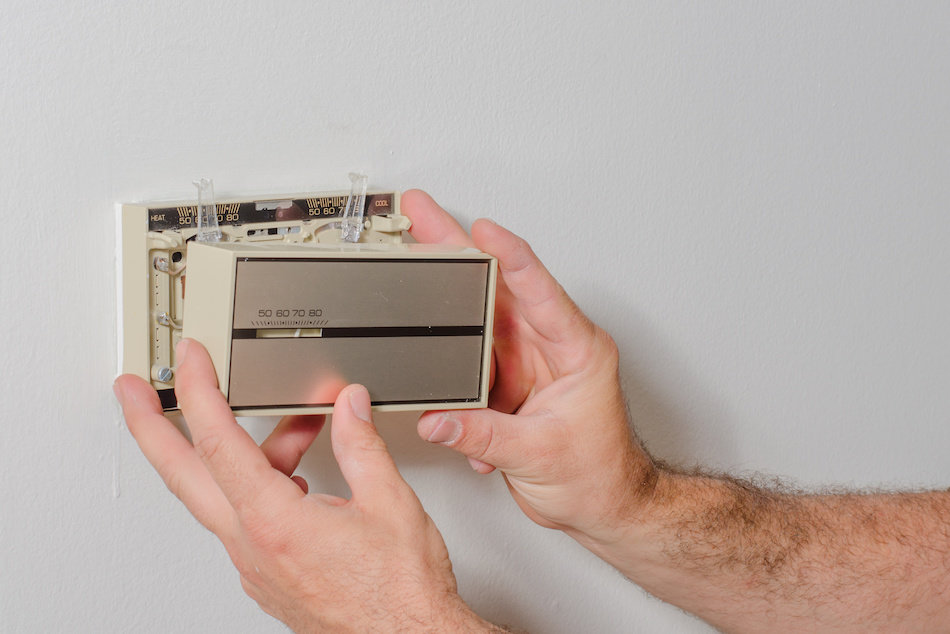
Manual thermostats are generally considered “old school” by today's standards and are found less and less frequently in homes. They are straight forward devices that are set manually by the homeowner to a desired temperature. While these manual thermostats have proven to be frequently indestructible, easy to use and inexpensive, they have some significant drawbacks.
- They often need to be reset
- They can waste energy
- They can be inaccurate
Manual thermostats often use a small metal coil that expands and contracts as temperatures rise and fall in the room where it is installed. This creates a connection or causes a disconnection with the heating or cooling unit. It activates the unit when the temperature is beyond set parameters and stops the system when the set temperature is achieved.
Because it can be inaccurate, frequently homeowners have to “ballpark” the room temperature setting based on feel rather than the actual temperature shown on the thermostat. Many times a manual thermostat's accuracy can be improved with a dusting using compressed air to remove any dust or particulate build up.
Manual thermostats are an endangered species, being replaced by more accurate and energy efficient digital devices. These include programmable and smart thermostats.
Programmable
Programmable thermostats are the first generation of digital devices used to control the room temperature in a home. The level of control, convenience, and energy efficiency afforded by a programmable thermostat will often depend on its age and level of complexity. A simple programmable thermostat, for example, will start and stop your HVAC system, activating it to reach a desired temperature at a specific time. Homeowners will often set their programmable thermostats to more energy saving temperatures when they are not at home but schedule it to reach more desired comfort levels based upon their anticipated return time. Others may desire cooler temperatures in the evenings. A programmable thermostat will usually not only let you set the temperature settings digitally but also control the temperature based on time of day.
More sophisticated programmable thermostats will allow greater flexibility in programming allowing for more changes throughout the day or week. This provides homeowners with a more efficient way to automate the temperature in their home based on their lifestyle.
While programmable thermostats offer much greater flexibility, accuracy, and potential energy savings than manual thermostats they can also be more expensive. This expense, however, is usually made up quickly by using less energy.
When purchasing a programmable thermostat, it is important to note that it has the features you desire. It is also important that programming instructions are completely read and fully understood for maximum benefit. Far too many homeowners use their programmable thermostats like manual ones, setting the temperature up and down as they see fit. This can bypass the desired convenience and functionality of having a programmable thermostat. It may also result in not achieving the expected energy savings this type of device can deliver.
Today's programmable thermostats are very affordable and are the most common replacement for manual thermostats. They must be understood and properly programmed to get full value, however.
Smart
Smart thermostats are the latest, most technologically advanced and energy efficient option when it comes to choosing a new thermostat for the home.
Tech-savvy homeowners will appreciate the convenience smart technology brings to controlling the inside temperature of a home. Because a smart thermostat is connected to Wi-Fi, it can be controlled from a smartphone anywhere in or out of the home. It can be turned on, off or adjusted on the way to or from work or at the office. Many smart thermostats have the ability to allow you to monitor when your HVAC system is in use, create run-time charts and energy use reports and even notify you when a filter should be changed.
Like a programmable thermostat, a smart thermostat should be fully understood in order to provide maximum convenience and minimal energy use. Many homeowners discover that a programmable thermostat, when used properly, delivers a similar amount of energy savings as a smart thermostat. That could be as much as 15% to 20% on an energy bill. That adds up quickly, and can be a great perk for anyone searching for homes in Edmonton. Those who enjoy using the latest technology and are interested in creating a smart home will appreciate the features many smart thermostats provide. They will also appreciate the fact that smart thermostats may also be upgraded as more updates are added in the future.
Before selecting a smart thermostat, make sure it has the features you expect and is compatible with your phone. You may also want to consider who and how many others should have control of your system.
Programming Pro Tips: How to Save Money and Reduce Waste
To make the most of an HVAC system it will be to a homeowner's advantage to fully understand the benefits and potential pitfalls of any system you choose. This will take some due diligence. Knowing what NOT to do is as important as knowing what to do if you want to get the most out of an HVAC system. Keep in mind, the savings can be substantial. Activists at the zero-waste blog EscapeWaste.com believe using a programmable or smart thermostat effectively can save up to 20% on energy. There is also the additional benefit of operating your HVAC system with less stress, potentially extending its lifespan.
Best Practices
Homeowners will often judge the efficiency of their HVAC system by the amount they owe each much on their energy bill. This can be deceiving, however. A bill, for example, can be larger or smaller based on the local temperatures during a given month or even by a larger surcharge, tax or a higher cost per kilowatt-hour. It can be helpful to focus on year-to-date kilowatt-hour usage rather than costs in determining if energy is being wasted.
It is also important to note that while a modern thermostat used properly may save significantly on an energy bill, it is not a cure-all for other energy-wasting issues. A new thermostat should be a part of overall home energy saving program that could include keeping HVAC filters clean, making sure a home is properly insulated and windows and doors are energy efficient. Replacement of older, energy gobbling major appliances as well as using low-voltage lighting will also help.
One of the best steps homeowners can take is analyzing when their home is vacant and setting temperatures on their thermostat lower or higher accordingly. It makes little sense to spend money unnecessarily on heating or cooling empty rooms. Keeping filters clean is also a simple, inexpensive step to take.
Households as a whole can also adjust their habits to save energy on their heating and cooling. Wearing long sleeves or a comfortable sweatshirt indoors is far more eco-friendly than cranking up the heat. The same for wearing short sleeves and lighter weight clothing in the summer.
Portable and ceiling fans are also an excellent way to keep air moving inside a home. Remember, ceiling fans are generally reversible. In cooler temperatures, they can draw warm air from the ceiling as heat rises, and push it back down to keep occupants warmer.
Natural sunlight can be your enemy during the warm weather months and a friend in cooler temperatures. If you've purchased a condo that faces the sunrise, you'll want to take this into account. Let the sunlight in to use its natural ability to warm your home in winter and draw the blinds or curtains to minimize its impact in the summer.
A few simple lifestyle changes along with a new, energy efficient thermostat can have an amazingly positive effect on energy use.
Common Misconceptions/Mistakes

There are several common misconceptions and mistakes people make when setting up thermostats in their homes. These mistakes either override the intended efficiency of an HVAC system or simply waste energy.
One such mistake is trying to cool or heat a room quicker by setting the thermostat unnecessarily low or high. Let's say, for example, the current temperature of a room is a warm 27°C/81°F and the desired temperature is 23°C/74°F. Setting the thermostat to 21°C/70°F will NOT cool it any faster. Keep in mind, a thermostat is essentially a sophisticated on-off switch. When it is “on” your system is heating or cooling as fast and efficiently as it was intended to. Setting it higher or lower to speed up the heating and cooling process will only cause your system to run longer. Set your thermostat at your desired temperature and allow it to do its job.
Another error homeowners make is constantly adjusting a thermostat. It helps to understand that HVAC systems use more energy the more frequently they go on. By constantly raising or lowering the temperature by resetting the thermostat, users are basically turning it on manually, making it less efficient. Again, finding a comfortable setting and allowing your HVAC system to perform is what will save energy ans money. While adjusting a thermostat too frequently can waste energy, so can not adjusting it enough, or at all. Settings should be adjusted, especially when the home will be empty for 8 hours or more. One rule of thumb is when a home will be vacant for 8 hours, set the thermostat around 3°C/7°F warmer in the summer and 6°C/12°F cooler in the winter.
This is where programmable and smart thermostats can really demonstrate their value, by being pre-set for workdays and by having the ability to control the HVAC remotely based on an anticipated arrival time.
Thermostat Installation
Installing a replacement thermostat is surprisingly easy, even if it is an upgraded programmable or smart device. Following a few simple steps will have the new thermostat in operation in no-time.
- Disconnect the power. Even a shock from the wiring of a low-voltage thermostat can get your attention, so make sure the breakers for the thermostat and HVAC system are turned off.
- Remove the cover of the old thermostat. Most will pry or pop off but some may have a screw that needs to be removed.
- Make note of where current wiring is connected. Take a picture or write down which wire is connected where. While this may not be necessary it can serve as a good back up.
- Disconnect the small wires from the thermostat. A small screwdriver will usually do the trick.
- Remove the wall mount. The old wall mount will usually be held in place by a couple of screws. After the screws are removed pull the mount off over the disconnected wires.
- Replace the wall mount and connect the wiring. Once the wiring is replaced, screw the new wall mount into the wall and replace the new faceplate.
- Turn the power back on and configure your new thermostat!
Where to Install
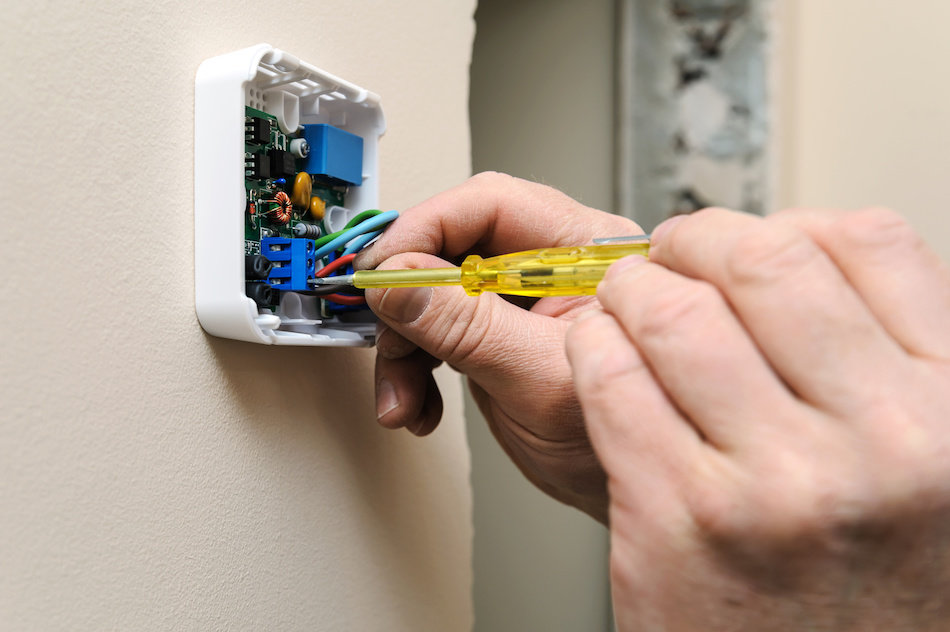
It is extremely important that thermostats be placed properly to operate at peak efficiency. If you are replacing a thermostat, changing locations can be quite the project, however, and you should seek the assistance and advice of a professional.
Avoid placing a thermostat:
- In or near kitchens.
- In direct sunlight.
- In hallways.
- Near doors or windows.
- Near air vents.
Ideal thermostat placement would be on an interior wall near the center of a home. Placing it in a living room where you may spend the most of your time is also beneficial since it will use the temperature in the room it is placed to control the temperature in your entire home.
DIY or Hire a Professional?
Should you attempt to replace a thermostat yourself or hire a professional? While replacing a thermostat is not necessarily complicated, it can take some confidence and a few tools.
Most low-voltage thermostats can be easily a DIY project, but you may want to consider a professional if yours is a line-voltage unit. You will also likely want to call in a pro if the location of the thermostat is changing or yours is a totally new installation.
If your present thermostat doesn't have a C-wire, or common wire, that runs continuous 24-volt power to the unit, you will also want to call in the help of a professional.
Common Terms and Settings
Actualized Fuel Utilization Efficiency (AFUE) – This is a measurement of the efficiency of a furnace. It is based on the percentage of heat produced for each dollar of fuel that is used. Like the mpg of an automobile, the higher the number, the more efficient it is on fuel.
British Thermal Units (BTU) - A measurement of heating capacity. A BTU is the amount of heat needed to increase the temperature of a pound of water by one degree Fahrenheit. The higher a systems BTU rating, the larger heating capacity it has.
Energy Efficiency Ratio (EER) – Measured in watts, EER is the ratio of cooling capacity an AC unit has compared to the power that is put in. A higher EER is more efficient.
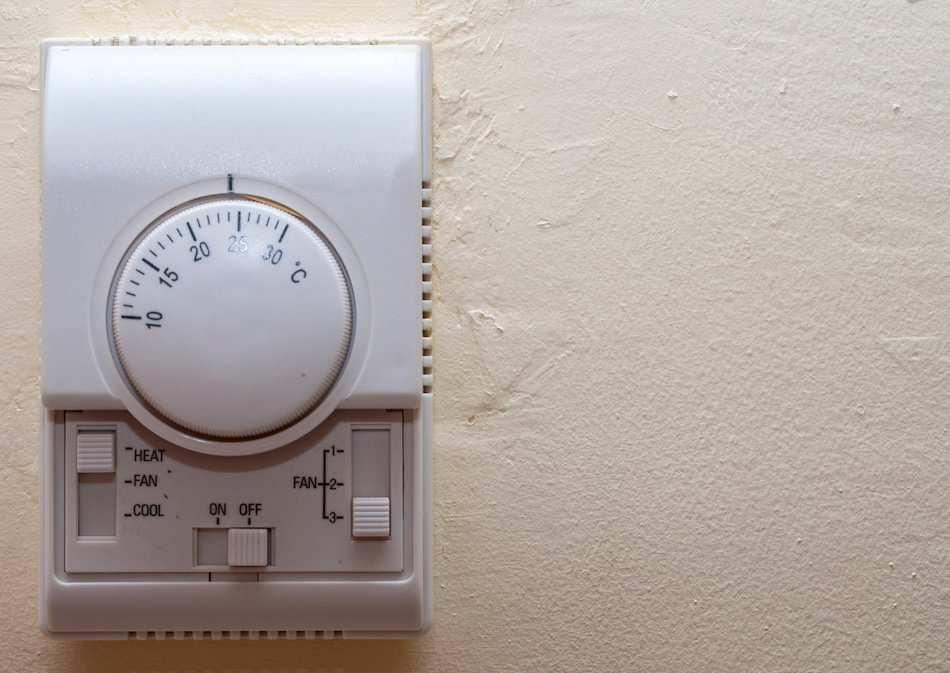
“Fan-Auto” Setting – This allows the fan to distribute air throughout a home automatically, once the heating or cooling unit is activated. When the desired temperature is reached, the fan will turn off with the heating or cooling system.
“Fan” Setting – The Fan setting controls the blower in your A/C unit. When turned on it distributes or blows air throughout a home.
HVAC – Heating, ventilation and air conditioning.
Kilowatt - A kilowatt is 1,000 watts.
Kilowatt-Hour (kWh) - This is a measurement of power defined by in use of 1,000 watts of power over a one-hour period. For example, a person could use one kilowatt-hour of energy by operating a 1,000 watt microwave for an hour, or by operating a 100 watt light bulb for 10 hours. Electric bills are most frequently calculated using kilowatt-hours.
“Run and Hold” Settings – This allows the operator to override previous settings of a thermostat, “holding” the current setting. For example, if you have your AC programed to a warming temperature while at work, but have the day off, using the Hold function will void that preprogrammed setting, keeping a home at its current temperature.
Common Issues/Troubleshooting Tips
Thermostats can last a few years or perform for decades. Manual thermostats have been known to be nearly indestructible, but do not offer the convenience and energy savings of more modern editions. Like any other mechanical or electrical device, the more complicated the thermostat is, the more likely it is to experience problems. In this section, we will look at some common symptoms of thermostat-related problems, how to troubleshoot the problems, what to check before changing a thermostat, how incorrect readings can impact energy use and comfort in a home and the potential limitations of programmable thermostats, using a thermostat, and how incorrect readings can impact energy use and comfort in a home.
Symptoms of a Malfunctioning Thermostat
Homeowners frequently discover a potential problem with a thermostat when they become either too warm or too cold in a room. If making adjustments to the thermostats doesn't resolve the issue or if your AC or furnace doesn't seem to be responding, there indeed, could be a problem with the thermostat.
Symptoms of a malfunctioning thermostat include:
- No digital display on the unit
- The HVAC doesn't respond to manual adjustments
- An AC or furnace may run constantly, not turning off at the desired setting
- Settings may not correspond to the actual room temperatures
When experiencing any of the above conditions, troubleshooting potential issues is relatively simple.
- Check the obvious, making sure your system is in the desired mode like “heat” or “cool” and if it has power.
- If the system is constantly operating, check to make sure the system is on “Auto” and not “On”. If the fan is set to on, it will blow whether the system is heating or cooling or neither.
- Adjust the settings up or down. When you turn setting upwards or downwards a few degrees you should hear a slight “click”, activating your system. In a short while, you should hear and feel the HVAC system engage.
- If it is a digital thermostat the battery may just need to be replaced. Batteries should be replaced annually.
- If it is an analog or manual thermostat, dust may be the problem. Remove the cover and lightly clean or blow out any dust.
- Check connections. Remove the cover and see if all the wiring is still securely connected.
- If the furnace or AC unit seems to be operating but no cooled or heated air is coming out of the vents, there may be a problem with the fan or fan motor. It is time to call a professional.
If the above steps don't lead to a resolution of the problem, it is best to call a local HVAC contractor to troubleshoot the system further.
Incorrect Temperature Readings
Of course, if your thermostat and room temperature are not in sync, your thermostat may indicate it is 22°C/72 degrees when it feels like 27°C/80°F. There are some common reasons this can occur.
One common reason is that your thermostat may simply be malfunctioning. This can be due to age, dust, and dirt or a mechanical failure. It also may need to be recalibrated to better align with the room temperature. This can be done by following the instructions for that specific unit. They often can be found online by visiting the manufacturer's website.
If you have an older thermostat with a mercury switch inside, it needs to be level. It may not have been installed properly or perhaps it got knocked out of place.
Another major reason a thermostat's settings may not align with actual room temperature is that it is installed in a poor location. If a thermostat is located in direct sunlight, on an outer wall or near a door or window it is likely to be influenced by the specific temperature in the area which may be far different than that elsewhere in the room. Relocating a thermostat to a better location may take the assistance of a professional. A professional can also help determine a location that will be more energy efficient and comfortable.
Before Throwing Out a “Broken” Thermostat
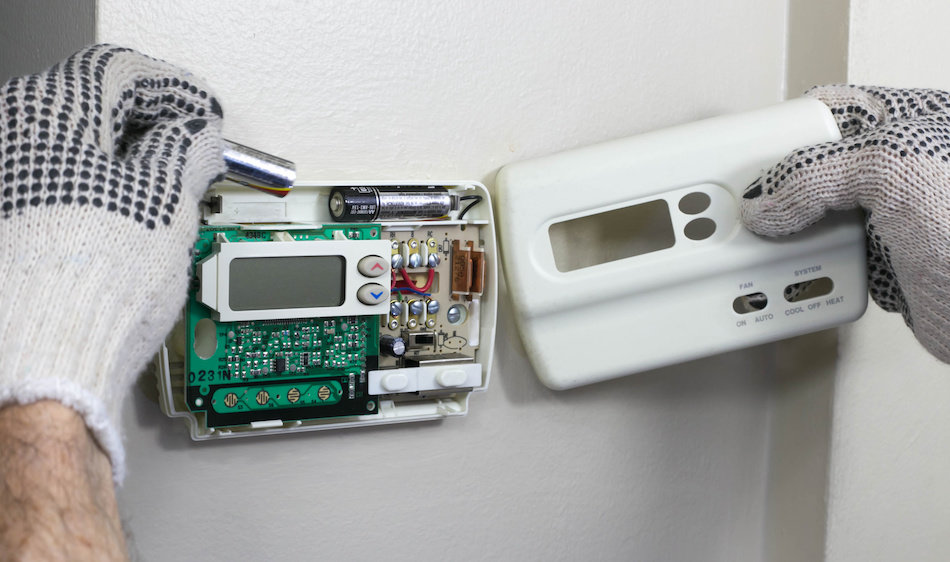
There are other steps you can also take before assuming your thermostat is “broken.”
Digital thermostats, for example, have a feature where they can be calibrated to the current room temperature. This will involve using a digital room thermometer and setting your thermostat to that current room temperature.
You can also bypass the thermostat to give you an indication if the problem is thermostat or equipment related. Turn off the breaker to the thermostat and HVAC unit. Take the cover off of the thermostat so you can have access to the wiring. Most thermostats will have wires labeled R, W, Y, G, and C. The R wire usually indicates it is the low-voltage 24-volt wire and the C is the common ground. If it is a digital thermostat that is battery operated it may not have a common ground. After you disconnect the wires from the thermostat connect the R wire and the W wire together and turn the breaker(s) back on. The furnace should start. After turning off the power once again, alternately connect the R wire to the Y wire which should activate the cooling unit. Repeat the process connecting the R wire to the G wire which should start the fan. If these units all operate when bypassing the thermostat you've determined that in fact, your thermostat is likely defective. After you are done troubleshooting, reconnect the wiring and replace the faceplate of the thermostat.
It is important to remember to disconnect the power to the thermostat as you conduct this wire testing, as well as between each step. If you are uncomfortable at all with performing these tests, contact a professional.
Possible Limitations for Programmable Thermostats
While programmable thermostats offer convenience, more accuracy, and energy savings, they are not ideal for all HVAC applications.
For example, when a heat pump is in cooling mode, it tends to act like an AC unit. This means turning up the temperature setting on the thermostat will save energy (and money) in this mode. However, when it is heating, setting back the thermostat may cause it to operate inefficiently. This, in turn, will nullify any potential savings. Homeowners may be better off simply maintaining a moderate temperature with a heat pump as opposed to trying to manipulate it through a programmable thermostat. There are heat pump-specific programmable thermostats entering the marketplace that are beginning to address this issue.
Programmable thermostats are also problematic for heat resistance systems like those used in baseboard heaters. Programmable thermostats that can control these 120-240 line-voltage systems are available but rare.
Programmable thermostats are also not practical for steam or radiant floor heating systems due to their slow response times to changes in settings. With some guesswork, experimentation, and anticipation, programmable thermostats on these systems can be set in anticipation of their slow start and stop times.
With these few exceptions, however, homeowners are discovering how to be more energy efficient through the proper use of programmable and smart thermostats.
Resources: What Temperatures/Settings are Best?
So, the ultimate question is what temperatures and settings are best? And this is a more complicated question than it seems. It can depend on climate, humidity, type of heating system, amount of insulation in a home, personal comfort preferences and more. It will also depend on if your goal is maximum energy savings or household comfort. The availability of financial resources to make upgrades is also a significant factor.
There are plenty of resources to help you determine the best temperatures and settings that may be best for you:
- An Equation to Help You Determine the Most Energy-Efficient Way to Set Your Thermostat
- An Infographic on 10 Thermostat Settings You Should Know
- Natural Resources Canada's guides to energy efficiency for homes
- U.S. Department of Energy Website on Choosing and Using Energy Efficient Thermostats
Striving for Efficient Comfort
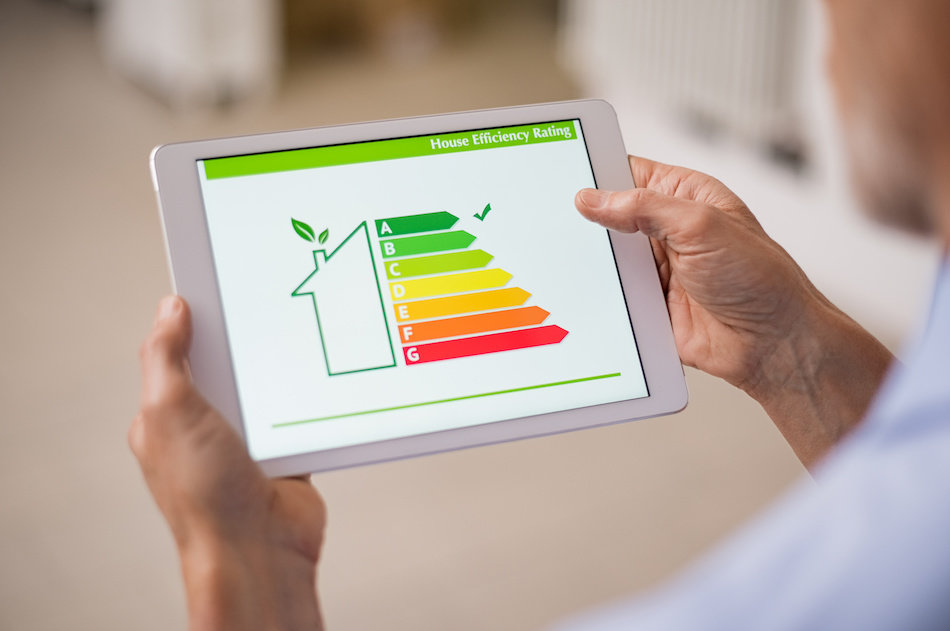
Most have heard the expression “If it's not broke, don't fix it.” That bit of wisdom just may not apply when it comes to an old, outdated manual thermostat. An older thermostat may be costing you in wasted energy and high heating and cooling bills. In addition, it may not be accurate enough to deliver the comfort level your household deserves.
It can pay dividends to proactively replace old manual/analog thermostats with more efficient and convenient programmable and smart thermostats. In fact, many of these modern thermostats are now so affordable and energy saving, they can literally pay for themselves in just a few months. Even more expensive Wi-Fi connected smart thermostats can return an investment in a year or so.
Replacing a current thermostat is certainly simple enough for most do-it-yourselfers. If you have any concerns with your capabilities or your unique set up, however, don't hesitate to call a professional. Remember, a thermostat will only perform up to expectations when installed and used properly. Read all instructions carefully and enjoy the convenience as well as energy and money savings that are sure to lie ahead.

